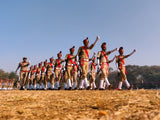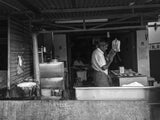Hari Singh Nalwa: The Most Feared Warrior Who Beat The Afghans
Known as the "most feared Sikh warrior," Hari Singh Nalwa was a renowned Sikh leader who once brought order to the chaotic troops in Afghanistan.
Reports have often used the tired cliche that Afghanistan is the "graveyard of empires" since the United States announced its plan to withdraw its soldiers from the nation.
It's undeniable that the Afghans are unbeatable on their territory. Despite invasions by the Soviet Union in the 1980s and the United States after September 11, the idea of Afghan invincibility on their land persists. Because no matter how well-equipped or powerful the opponent may be, an Afghan will not give ground.
However, a legendary Sikh commander, Hari Singh Nalwa had once conquered Afghanistan's notoriously uncontrollable forces and became known as the "most feared Sikh warrior."
Who is Hari Singh Nalwa?
In the Uppal household of Gujranwala, little Hari Singh Nalwa was born to Sardar Gurdial Singh and Dharam Kaur in 1791. He was born and raised with no siblings; his family had come from Majitha town, not far from Amritsar. In 1762, his grandfather, Sardar Hardas Singh, died while serving the Sukarchakia Misl (to whom Ranjit Singh also belonged) in an expedition. Gurdial Singh's father followed in his footsteps as a Deradar, serving under Sukarchakia Sardars Charat Singh and Mahan Singh in several wars. After he died in 1798, Hari Singh's maternal uncle took him in and raised him as his own. Hari Singh was just seven years old.
From Uppal to ‘Nalwa’
Something happened during Hari Singh Nalwa's early duty days in the Khalsa army. Hari Singh was attacked by a tiger while on a hunting trip. He didn't have time to draw his sword because he was attacked stealthily and unexpectedly. Bravely stepping up to the challenge, Hari Singh, still a young man, grabbed the beast's jaw with his hands and pushed it aside before dispatching it with his sword. Legend has it that he earned the name Nalwa after "having cloven the head of a tiger who had already seized him as its pray," as noted by historian, Baron Charles Hugel
 Photo credit: newsonair.com
Photo credit: newsonair.com
The Commander; Hari Singh Nalwa
When it came to leading the army of Maharaja Ranjit Singh, Hari Singh Nalwa was among the most reliable officials. He served as Governor of Kashmir, Hazara, and Peshawar provinces.
After conquering the Afghans and taking control of territory along Afghanistan's border, Nalwa became a household name. He, also shut off the Khyber Pass, the primary entry point for foreign invaders into the sub-continent from around the year 1000 to the early 19th century, denying the Afghans access to Punjab.
Mothers in Afghan tradition would bring Nalwa's name to calm down their misbehaved children. "If you don't stop sobbing, Haria Ragle (Hari Singh Nalwa) will show up," stated former Guru Nanak Dev University vice-chancellor Dr. S P Singh.
Further, Dr Singh said that Nalwa was responsible for keeping the Afghans from penetrating the northwest boundary by seizing control of numerous districts near the Afghanistan border and the Khyber Pass.
When the Afghans attempted to invade Punjab and Delhi, Maharaja Ranjit Singh decided to fortify his kingdom. There were two distinct armies he assembled. In one of them, he used a multinational army that included French, German, Italian, Russian, and Greek troops and cutting-edge equipment. Later, he turned the second army over to Nalwa, who "had already beaten thousands of Hazars, an Afghan tribe, that were three times their size," as Dr. Singh put it.
India's government issued a stamp honoring Nalwa in 2013 for his unparalleled courage.
The Battles Against Afghans That Made Them Fear Nalwa
The Battle of Kasur
During the year 1807, Hari Singh Nalwa launched his first major military expedition in the region of Kasur. Hari Singh Nalua led an army to Kasur to overthrow the Afghani owner Kutab-Ud-Din Khan. After a three-month siege, Kutab-Ud-Din surrendered to the Sikhs. When Hari Singh Nalua's Sher-Dil-Rajman division arrived at the city gate of Kasur, they were the first to do so.
The Battle of Attock
The fort of Attock, the site of the Battle of Attock in 1813, served as an important supply depot for any troops crossing the Indus River. Dewan Mokham Chand, Maharaja Ranjit Singh's commander, led the Sikhs to victory against Azim Khan and his brother Dost Mohammad Khan. They were fighting on behalf of Shah Mahmud of Kabul. Other than Hari Singh Nalwa, significant others who fought in this war were Hukam Singh Attariwala, Shyamu Singh, Khalsa Fateh Singh Ahluwalia, and Behmam Singh Malliawala. The Sikhs had never been victorious over the Durranis and the Barakzais, but this was their day.
The Battle of Peshawar
When Shah Mahmud's son Shah Kamran assassinated the Barakzai Vazir Fateh Khan of the Kingdom of Kabul in August 1818, Peshawar, the summer capital, became a tributary. A large Sikh army crossed the Indus River and invaded Peshawar for the first time to take advantage of the situation. After the Sikh military took control of Peshawar, Hari Singh Nalwa was sent to guard the frontier between Afghanistan and Pakistan.
Battle of Mankera
 Photo credit: Indiatimes.com
Photo credit: Indiatimes.com
Mankera and Mitha Tiwana exerted much influence on the Sindh Sagar Doab in 1822. Nawab Hafiz Ahmed Khan, a Durrani kin, was quite powerful in this area. Along with Mankera, he oversaw a huge territory defended by 12 forts. Attock, Mankera, Mitha Tiwana, and Khushab's governors had proclaimed independence from Kabul as the central government's authority waned. The timing was perfect for Ranjit Singh to defeat Hafiz Ahmad Khan and gain control of Singh Sagar Doad. He ordered Hari Singh, the ruler of Kashmir at the time, to meet up with the Lahore Army that was already marching towards the Indus River. In the center of the Thal, you may find the fortress of Mankera. It was dug into the ground and included a castle made of burning bricks in the center of a dry moat. The Nawab banned digging wells within a 15-kilometer radius of the core citadel to seal it off from the populace. During the evening of November 26th, Hari Singh Nalwa and the other chiefs and Jagirdars set up their morchas within a long shooting range of the location. Upon discovering abandoned wells, the crew promptly cleaned them out and dug new ones. They came closer to the ditch on the evenings of December 6 and 7. Consequently, the next conflict was bloody and claimed many lives. There were 25 days of intense fighting around the Mankera fort. By the end of it all, the Nawab had conceded defeat, and the Sikhs had taken the last remaining Saddozai fortress.
Battle of Jamrud or known as “The Final Battle”
 Painting Credit: Jason Askew
Painting Credit: Jason Askew
Soon after Dussehra in 1836, Hari Singh Nalwa took control of Jamrud, a fort guarding the entrance to the Khyber Pass. With this win under their belt, the Sikhs were ready to start an onslaught in Kabul. This triumph terrified the Dost Mohammed Khan of Kabul. However, the situation shifted when the Maharaja's grandson, Nau Nihal Singh, wed in 1837. Soldiers were evacuated from around Punjab to put up a show of might for the British Commander-in-chief who was in attendance.
Even though Mohammed Khan had been invited to the big party, he decided to stay home. He seized the moment to capture Jamrud. Expecting this to happen, Hari Singh Nalwa stayed behind in Peshawar rather than traveling to Amritsar.
With his five sons and top advisers in tow, Dost Mohammed sent his army marching towards Jamrud with strict instructions to avoid fighting with the Sikhs. More of a show of force was made to seize the forts of Shabqadar, Jamrud, and Peshawar. Awaiting the arrival of troops from Lahore, Hari Singh was also instructed to avoid fighting the Afghans.
Mahan Singh, Hari Singh's second-in-command, was holed up in the Jamrud citadel with 600 troops and few supplies. From Peshawar, Hari Singh proceeded to rescue his soldiers trapped in the little citadel, encircled on all sides by Afghan forces and with no water. Even though the Sikhs were outnumbered dramatically, the unexpected appearance of Hari Singh Nalwa caused complete and utter fear among the Afghans. During the chaos, Hari Singh Nalwa received life-threatening injuries.
In his last moments, he ordered his lieutenant to keep his death a secret until reinforcements arrived. The Afghans had known for nearly a week that Hari Singh had been injured, but they did nothing as they waited for confirmation of his death. Lahore's soldiers arrived just in time to see the Afghans retreat to Kabul.
By holding the line at Jamrud and Peshawar, Hari Singh Nalwa also stopped the Afghans from devastating the rest of the (modern day Pakistan's) north-western border.
The Significance of Triumph Against Afghans
 Photo Credit: Republic World
Photo Credit: Republic World
Some historians argue that the territory that is now Pakistani Peshawar and the Northwest Frontier was a former part of Afghanistan but would have been part of Pakistan had Maharaja Ranjit Singh and his commander Nalwa not seized control of the region. This may have prompted further Afghan invasions of Punjab and Delhi.
Final Thoughts on Hari Singh Nawla, the Sikh Empire, Punjab, Delhi and Afghanistan
General Hari Singh Nalwa was an ingenious speaker, a capable administrator and brilliant strategist who brought peace and prosperity to the people of Kashmir as its Governor. He united all of Punjab once more when he drove out invaders who had divided it into numerous provinces for over 800 years. His construction of protective forts around Lahore and Delhi, though greatly outnumbered by enemies always gave him victory against foreign invasions. His achievements were largely due to his devotion to Sikhi; always putting others before himself so that they could live in freedom and happiness.



